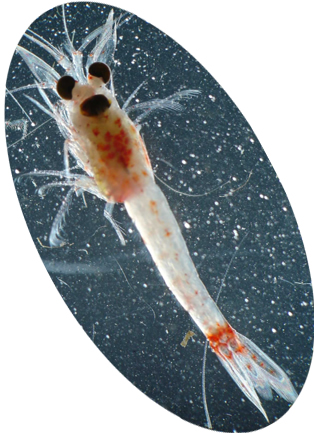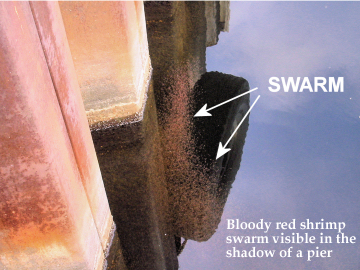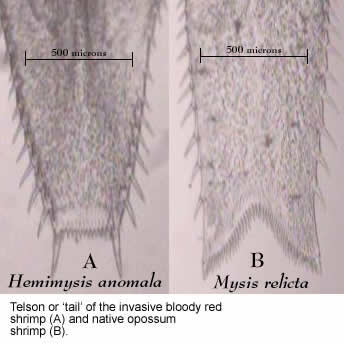Hemimysis anomala Brochure
Great Lakes New Invader: Bloody Red Shrimp (Hemimysis anomala)
 The “bloody-red shrimp” Hemimysis anomala, was first
reported in the Great Lakes by NOAA from samples collected in Muskegon, Michigan in November
of 2006 in waters connected to Lake Michigan. It is a small shrimp-like crustacean (order
Mysidacea) native to the low-salinity margins of the Black Sea, the Azov Sea, and the
eastern Caspian Sea and most likely was brought into the Great Lakes via ballast tanks.
However, mysids are also used by aquarists as a high-nutrition food for aquarium fish,
although we have not found any records that Hemimysis is used
this way.
The “bloody-red shrimp” Hemimysis anomala, was first
reported in the Great Lakes by NOAA from samples collected in Muskegon, Michigan in November
of 2006 in waters connected to Lake Michigan. It is a small shrimp-like crustacean (order
Mysidacea) native to the low-salinity margins of the Black Sea, the Azov Sea, and the
eastern Caspian Sea and most likely was brought into the Great Lakes via ballast tanks.
However, mysids are also used by aquarists as a high-nutrition food for aquarium fish,
although we have not found any records that Hemimysis is used
this way.
Mysids are often called opossum shrimp because females typically their eggs in a pouch. They are free swimming when not resting on the bottom of other surfaces. They have eight pairs of legs rather than the five typically found on larger shrimps and other decapods.
The main Muskegon population was found in a swarm of over 300 individuals per m3. It has also been found in samples taken in Lake Ontario off Oswego, New York. In both locations, adults, juveniles, and pregnant females were found, indicating that this species is reproduction in the Great Lakes. Finding the bloody red shrimp in two separate locations indicates that the species may be wide-spread, and experts expect that it will be seen in additional locations as scientists begin actively looking for it. The impact on the Great Lakes is yet unknown, but based on its history of invasion across Europe, significant impacts are possible.
NOAA Research: Help Needed to Document the Spread of this Species!
 The NOAA National Center
for Research on Aquatic Invasive Species
(NCRAIS), in Ann Arbor, is coordinating
a national rapid research response to
define the range, distribution, and
impact of the bloody red shrimp in the
Great Lakes. It prefers habitats associated
with hard structures or rocky bottoms
and actively avoids direct sunlight.
It has a unique swarming behavior unlikely
to be confused with anything else in
the Great Lakes. During daylight hours,
especially in late summer, it may be
observed forming reddish swarms in
the shadows of piers, boats, or breakwalls.
Swarms disperse at night, but in clear
calm waters, the bloody red shrimp may
be detected at night by shining a bright
light on the water–the shrimp
will rapidly swim away from the light.
Help is needed to document and prevent
the spread of this species! We are asking
the public’s
help in documenting other
locations around the
Great Lakes basin where this species
has spread. Look for swarms in shadowed
areas along the shoreline, especially
near breakwalls, docks, channel edges,
and near boats. If you see what you
believe to be a swarm, please report
your observations.
The NOAA National Center
for Research on Aquatic Invasive Species
(NCRAIS), in Ann Arbor, is coordinating
a national rapid research response to
define the range, distribution, and
impact of the bloody red shrimp in the
Great Lakes. It prefers habitats associated
with hard structures or rocky bottoms
and actively avoids direct sunlight.
It has a unique swarming behavior unlikely
to be confused with anything else in
the Great Lakes. During daylight hours,
especially in late summer, it may be
observed forming reddish swarms in
the shadows of piers, boats, or breakwalls.
Swarms disperse at night, but in clear
calm waters, the bloody red shrimp may
be detected at night by shining a bright
light on the water–the shrimp
will rapidly swim away from the light.
Help is needed to document and prevent
the spread of this species! We are asking
the public’s
help in documenting other
locations around the
Great Lakes basin where this species
has spread. Look for swarms in shadowed
areas along the shoreline, especially
near breakwalls, docks, channel edges,
and near boats. If you see what you
believe to be a swarm, please report
your observations.
Fish gut contents: several reports have been received of apparent Hemimysis remains being found in the stomach contents of fish, so another way to potentially find Hemimysis is to look at the stomach/gut contents of freshly-caught fish. However, we need to verify that it is Hemimysis and to do so we need a sample of the stomach contents. Place the sample in a small container and refrigerate it, or cover it with alcohol, and contact us. We’ll send you mailing instructions or arrange for someone to collect the sample from you.
Stop Aquatic Hitchhikers!
The bloody red shrimp is considered a ‘high risk’ for invasion of inland lakes in the Great Lakes region. Its history of invading canals, streams, lakes, and reservoirs throughout Europe also indicate the potential for significant impacts to our inland lake systems. Do not transport live bloody red shrimp! While these animals bear live young, juveniles are not easily visible to the naked eye.
To help prevent the spread of this
animal, follow the precautions outlined by the:
Stop Aquatic Hitchhikers Campaign
(www.protectyourwaters.net)
Identification
 The bloody red shrimp
is a mysid, a relative of the native Great Lakes opossum shrimp,Mysis relicta
(identified in some recent scientific literature
as Mysis diluviana). Both species have stalked eyes and are
generally less than 1/2 inch in length–the invader tends to
be slightly smaller, though size ranges overlap. The bloody
red shrimp is more red in color, and the native species is more
clear, though both can be quite variable. Preserved animals
tend to lose coloration. The best way to tell the two species
apart is by the shape of the tail (requiring a hand lens or low
magnification microscope)–the native Mysis has a deeply
forked tail, whereas the new invader has a flat end to its tail
with two prominent terminal spines. Identifications should
be confirmed by an expert as several other mysid species
are also invading across Europe with significant potential to
become established in North America.
The bloody red shrimp
is a mysid, a relative of the native Great Lakes opossum shrimp,Mysis relicta
(identified in some recent scientific literature
as Mysis diluviana). Both species have stalked eyes and are
generally less than 1/2 inch in length–the invader tends to
be slightly smaller, though size ranges overlap. The bloody
red shrimp is more red in color, and the native species is more
clear, though both can be quite variable. Preserved animals
tend to lose coloration. The best way to tell the two species
apart is by the shape of the tail (requiring a hand lens or low
magnification microscope)–the native Mysis has a deeply
forked tail, whereas the new invader has a flat end to its tail
with two prominent terminal spines. Identifications should
be confirmed by an expert as several other mysid species
are also invading across Europe with significant potential to
become established in North America.
Habitat
The bloody red shrimp is most frequently found over hard bottom surfaces, including rocks and shells. It is unknown at this point whether zebra and quagga mussel beds in the Great Lakes will be suitable habitat for the shrimp. The species avoids soft bottoms. In its native range, across Europe and in the Baltic Sea, the bloody red shrimp is found in water depths to 50 meters (166 feet). It seems to prefer slow moving waters, but has been found along rocky, wave-exposed shorelines. The shrimp is also reported to spend daylight hours hiding in rocky crevasses and boulder cavities, but has also been observed swarming in shadowed areas near the surface by day.

Native Range
The bloody red shrimp is native to the Ponto-Caspian region of eastern Europe–the same area that zebra mussels came from. Like zebra mussels, it spread across Europe, reaching the Baltic Sea in 1992 and the United Kingdom in 2004.
Life History
Bloody red shrimp have an individual life span of about 9 months, grow to adults in just 45 days, and can produce up to four generations per year. This lifecycle is significantly more rapid than the native opossum shrimp. Females have been documented to carry up to 66 eggs in a clutch. Broods carried by females in the Muskegon population ranged from 2 to 7.
Potential Impacts
The bloody red shrimp is an omnivore, eating a variety of smaller animals and algae. Their diet includes waterfleas and algae. They may compete with young fish, while providing food for larger fish.
